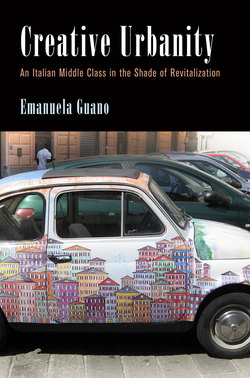Creative Urbanity

Реклама. ООО «ЛитРес», ИНН: 7719571260.
Оглавление
Emanuela Guano. Creative Urbanity
Отрывок из книги
Creative Urbanity
Kirin Narayan and Alma Gottlieb, Series Editors
.....
Chapters 4 and 5 delve into the experiences of two social groups whose poiesis (Calhoun, Sennett, and Shapira 2013) has made substantial contributions to Genoa’s public image as a “city of culture”: street antique dealers and walking-tour guides. Chapter 4 describes how, since the mid-1990s, a proliferation of antique fairs have given chronically under- and unemployed middle-class women an opportunity for self-employment. This chapter explores how middle-class women antique dealers draw on their gendered and classed skills such as their aesthetic sensibility to stake out a place for themselves in an urban economy of culture, even though the domestic and decorative aura that at times surrounds women’s endeavors may still undermine their efforts. Drawing on an ethnography of how Genoa’s walking-tour guides describe and present the city as well as on the analysis of their professional histories and experiences, Chapter 5 suggests that these protagonists of Genoa’s newly found tourist vocation are agentive cultural intermediaries who mediate between high and popular culture as they shape the urban experiences of their publics. Acting independently from the political and corporate entities that traditionally drive the transformation of postindustrial cities into consumption hubs, Genoa’s walking-tour guides draw on their own creativity, their talents, and their educational background to generate venues of self-employment by spinning tales of concealment and discovery around the master narrative of Genoa’s industrial decline and its tourist potential.
While Chapter 4 and 5 focus on the experiences and biographies of some of Genoa’s creative individuals, Chapter 6 dwells on the kind of worlding practices that may emerge in the shade of revitalization. This chapter is an ethnography of the Suq (Souk): a multicultural festival held in Genoa every year under the supervision of two women who, since the late 1990s, have used their background in sociology, political science, and theater to further the cause of diversity in Genoa. Multicultural festivals have been frequently denounced as opportunities for the consumption of “other” cultures that are added as commoditized and politically irrelevant “spices” to the otherwise allegedly “bland” everyday life of mainstream groups (hooks 1992; Kirshenblatt-Gimblett 1991). Yet these critiques often fail to explore how such events articulate with sensuous modalities of constructing dominant identities. This chapter seeks to contextualize the Suq within the broader politics of representing and consuming selves and others in contemporary Italy, and it argues that the Suq’s specific brand of strategic orientalism attempts to penetrate the Italian sensorium for the sake of challenging hegemonic representations of culture, identity, belonging, and roots. Just as importantly, this chapter suggests that, in a society where small businesses are a fundamental source of livelihood for both natives and immigrants, the Suq supports an alternative to forms of consumption increasingly shaped by the shopping malls and the big-box stores that, since 2000, have proliferated in Genoa’s deindustrialized peripheries, bringing about blight in formerly thriving neighborhoods.
.....